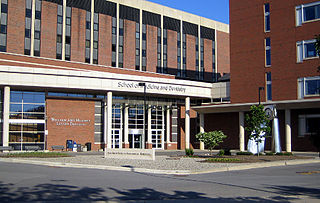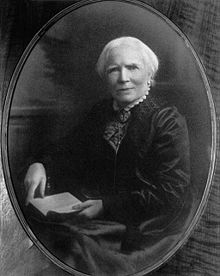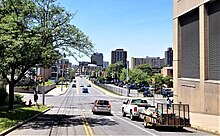
Baylor College of Medicine (BCM) is a medical school and research center in Houston, Texas, within the Texas Medical Center, the world's largest medical center. BCM is composed of four academic components: the School of Medicine, the Graduate School of Biomedical Sciences; the School of Health Professions, and the National School of Tropical Medicine.
The University of Texas Southwestern Medical Center is a public academic health science center in Dallas, Texas. With approximately 23,000 employees, more than 3,000 full-time faculty, and nearly 4 million outpatient visits per year, UT Southwestern is the largest medical school in the University of Texas System and the State of Texas.

New York Medical College is a private medical school in Valhalla, New York. Founded in 1860, it is a member of the Touro University System.

The Emory University School of Medicine is the graduate medical school of Emory University and a component of Emory’s Robert W. Woodruff Health Sciences Center. Emory University School of Medicine traces its origins back to 1915 when the Atlanta Medical College, the Southern Medical College (1878), and the Atlanta School of Medicine merged.

The Indiana University School of Medicine (IUSM) is a major, multi-campus medical school located throughout the U.S. state of Indiana and is the graduate medical school of Indiana University. There are nine campuses throughout the state; the principal research, educational, and medical center is located on the Indiana University–Purdue University Indianapolis (IUPUI) campus in Indianapolis. With 1,461 MD students, 195 PhD students, and 1,442 residents and fellows in the 2023–24 academic year, IUSM is the largest medical school in the United States. The school offers many joint degree programs including an MD/PhD Medical Scientist Training Program. It has partnerships with Purdue University's Weldon School of Biomedical Engineering, other Indiana University system schools, and various in-state external institutions. It is the medical school with the largest number of graduates licensed in the United States per a 2018 Federation of State Medical Boards survey with 11,828 licensed physicians.
The University of Texas Health Science Center at Houston (UTHealth) is a public academic health science center in Houston, Texas, United States. It was created in 1972 by The University of Texas System Board of Regents. It is located in the Texas Medical Center, the largest medical center in the world. It is composed of six schools: McGovern Medical School, The University of Texas MD Anderson Cancer Center UTHealth Graduate School of Biomedical Sciences, UTHealth School of Dentistry, Cizik School of Nursing, UTHealth School of Biomedical Informatics and UTHealth School of Public Health.
NYU Grossman School of Medicine is a medical school of New York University (NYU), a private research university in New York City. It was founded in 1841 and is one of two medical schools of the University, the other being the NYU Grossman Long Island School of Medicine. Both are part of NYU Langone Health,an academic medical center named after Kenneth Langone, the investment banker and financial backer of The Home Depot.

SUNY Downstate Medical Center is a public medical school and hospital in Brooklyn, New York. It is the southernmost member of the State University of New York (SUNY) system and the only academic medical center for health education, research, and patient care serving Brooklyn's 2.5 million residents. As of Fall 2018, it had a total student body of 1,846 and approximately 8,000 faculty and staff.

The University of Rochester Medical Center (URMC), now known as UR Medicine, is located in Rochester, New York, is one of the main campuses of the University of Rochester and comprises the university's primary medical education, research and patient care facilities.
The University of Illinois College of Medicine offers a four-year program leading to the MD degree at four different sites in Illinois: Chicago, Peoria, Rockford, and formerly Urbana–Champaign. The Urbana–Champaign site stopped accepting new students after Fall 2016 to make room for the newly established Carle Illinois College of Medicine.

The Joan & Sanford I. Weill Medical College of Cornell University is Cornell University's biomedical research unit and medical school in New York City.

NYU Langone Health is an academic medical center located in New York City, New York, United States. The organization consists of the NYU Grossman School of Medicine and NYU Grossman Long Island School of Medicine, both part of New York University (NYU), and more than 300 locations throughout the New York metropolitan area, including six inpatient facilities: Tisch Hospital; Kimmel Pavilion; NYU Langone Orthopedic Hospital; Hassenfeld Children's Hospital; NYU Langone Hospital – Brooklyn; and NYU Langone Hospital – Long Island. It is also home to Rusk Rehabilitation. NYU Langone Health is one of the largest healthcare systems in the Northeast, with more than 46,000 employees.
Medical centers in the United States are conglomerations of health care facilities including hospitals and research facilities that also either include or are closely affiliated with a medical school. Although the term medical center is sometimes loosely used to refer to any concentration of health care providers including local clinics and individual hospital buildings, the term academic medical center more specifically refers to larger facilities or groups of facilities that include a full spectrum of health services, medical education, and medical research.

Geneva Medical College was founded on September 15, 1834, in Geneva, New York, as a separate department (college) of Geneva College, currently known as Hobart and William Smith Colleges. In 1871, the medical school was transferred to Syracuse University in Syracuse, New York.
The University of Tennessee College of Medicine is one of six graduate schools of the University of Tennessee Health Science Center (UTHSC) in downtown Memphis. The oldest public medical school in Tennessee, the UT College of Medicine is a LCME-accredited member of the Association of American Medical Colleges (AAMC) and awards graduates of the four-year program Doctor of Medicine (MD) degrees. The college's primary focus is to provide practicing health professionals for the state of Tennessee.

The Renaissance School of Medicine (RSOM) is the graduate medical school of Stony Brook University located in the hamlet of Stony Brook, New York on Long Island. Founded in 1971, RSOM is consistently ranked the top public medical school in New York according to U.S. News & World Report. RSOM is one of the five Health Sciences schools under the Stony Brook Medicine healthcare system.

University at Buffalo School of Medicine and Biomedical Sciences, also known as Jacobs School of Medicine and Biomedical Sciences, is a public medical school in the city of Buffalo, New York, at the University at Buffalo. Founded in 1846, it is one of the oldest medical schools in the United States and is the only medical school in Buffalo. It is part of the State University of New York (SUNY) system.

The SUNY Downstate Health Sciences University is a public medical school in Brooklyn, New York City. The university includes the College of Medicine, College of Nursing, School of Health Professions, School of Graduate Studies and School of Public Health.
Patricia Joy Numann is an American endocrine surgeon. She is the founder of the Association of Women Surgeons, former president of the American College of Surgeons, and professor emeritus at the State University of New York Upstate Medical University.

Upstate University Hospital is a 752-bed non-profit, teaching hospital located in Syracuse, New York. Upstate University Hospital is a part of the Upstate Health System, as the flagship hospital in the system. As the hospital is a teaching hospital, it is affiliated with the Norton College of Medicine at State University of New York Upstate Medical University. The hospital is also an American College of Surgeons verified Level 1 Trauma Center, the only in the region and one of 21 in New York. Attached to the hospital is the Upstate Golisano Children's Hospital that treats infants, children, teens, and young adults aged 0–21.






























